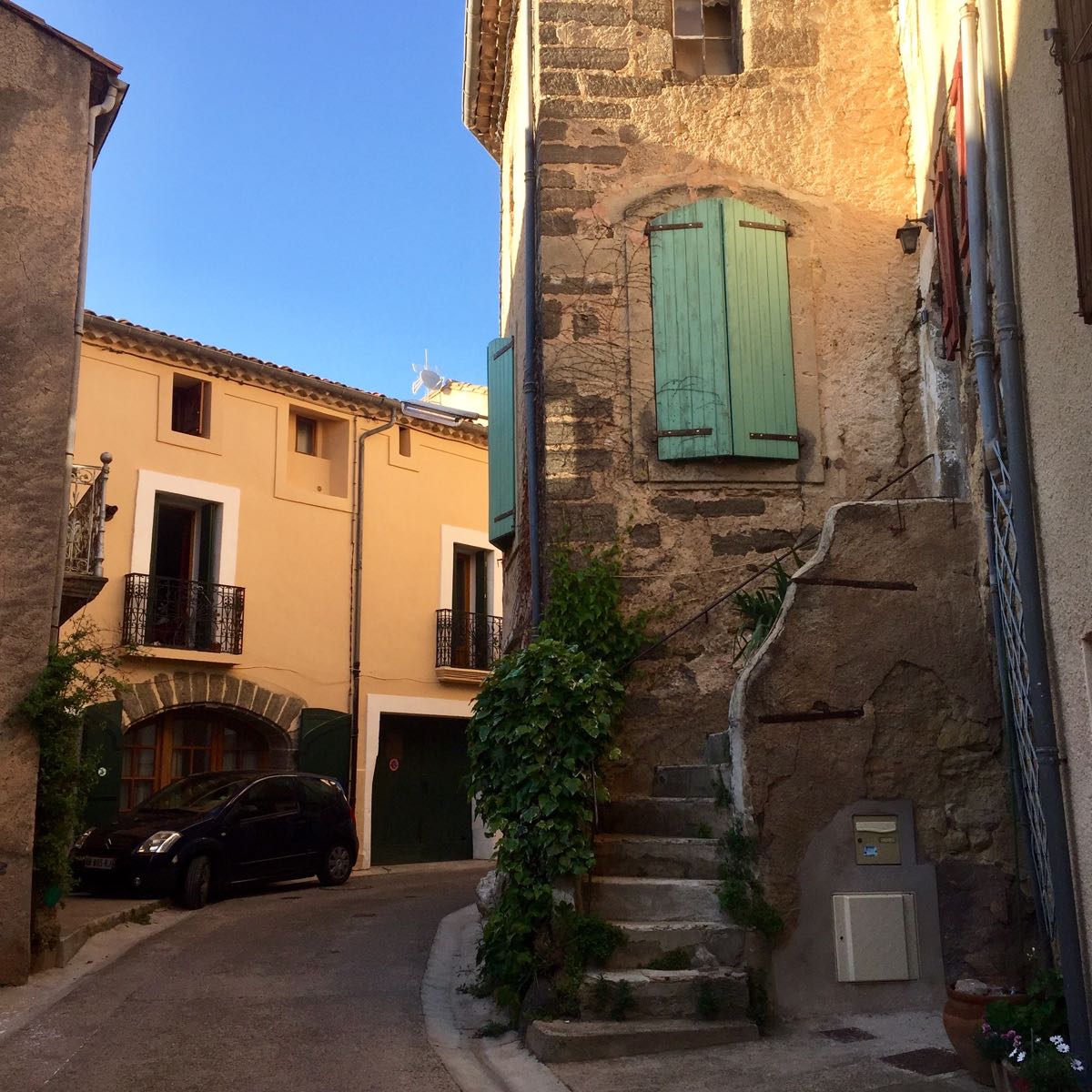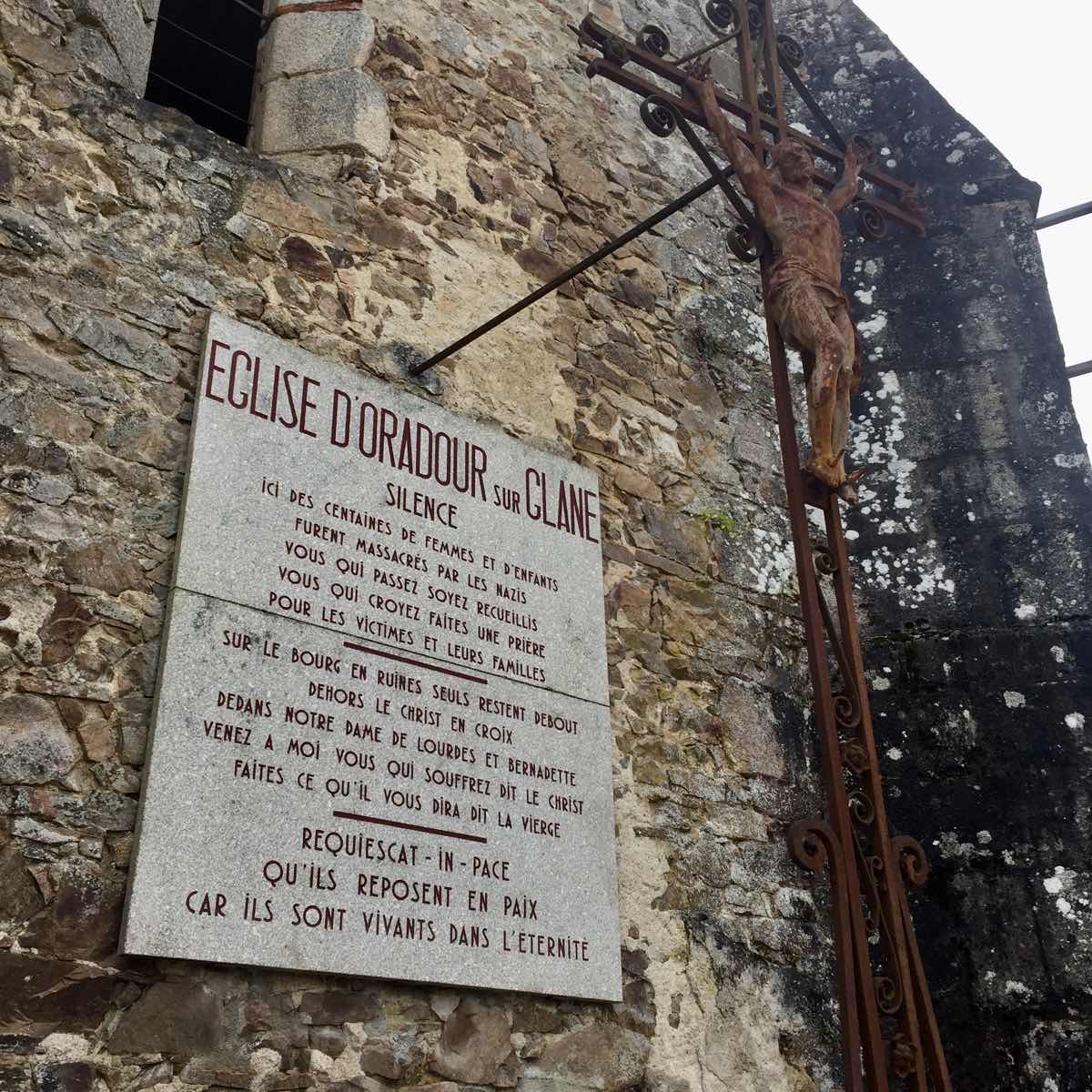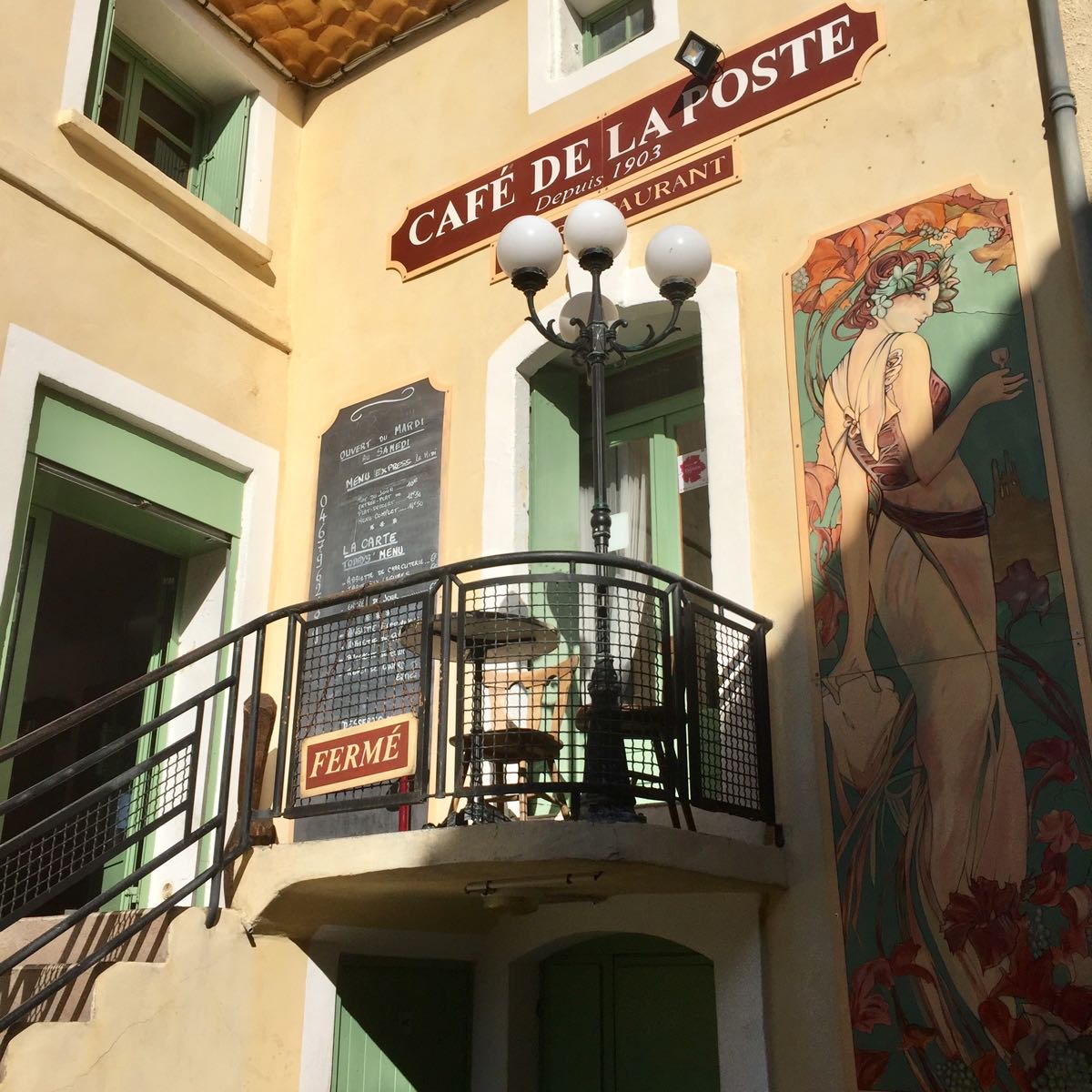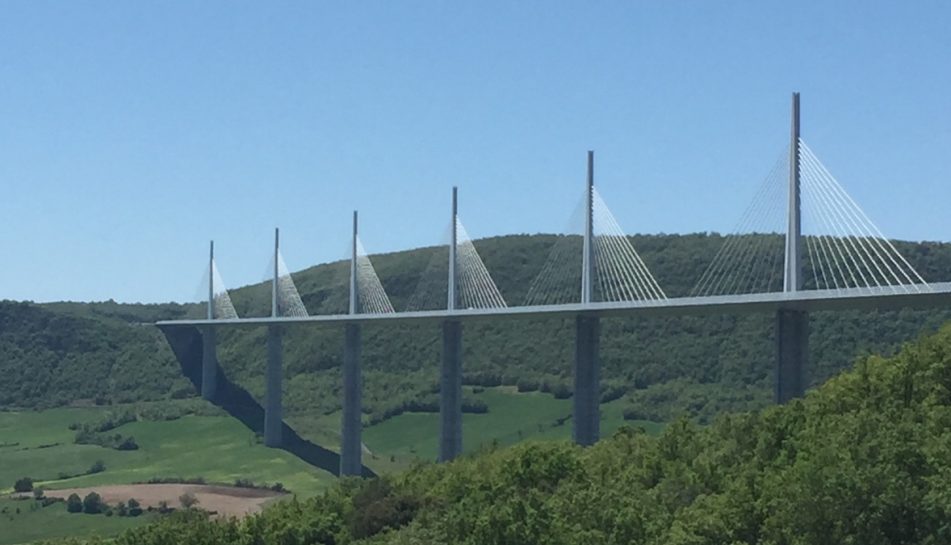Mindful that unrealistic expectations have a habit of being like premeditated resentments, we’ve been trying our best not to have any. Nevertheless, we both know that today, our fifth riding through France, should gift us lasting memories of ambitions fulfilled. The speed with which we’ve covered the final 120 miles south, from Issoire along the curvaceous A75, reflects our growing sense of anticipation.
As with many a good idea, this one was born from a conversation over a pint outside a country pub. My friend, Andy Winters, is the drummer in a band called the Sundogs and we were passing the time while his musical accomplices finished tuning up before their gig got underway. “I’d love to ride the Millau Viaduct one day,” he said out of the blue. “Well why don’t you then?” I replied.
That was in February. Now it’s early May and we’ve settled into the rhythm of travelling together on what will be a 2,000-mile loop from Cherbourg to the Mediterranean and back. Andy’s on his highly customised Yamaha Fazer 1000, which has at least four times the grunt of the impeccable Benelli TRK 502 I’m long-term testing for Overland. We mostly stick to the speed limits with me riding in front, but sometimes Andy takes the lead and does an admirable job of restraining his throttle hand so I can keep up. This morning is one of those times. The world’s tallest bridge, at 343m it stands taller than the Eiffel Tower, looms larger in Andy’s imagination than it does in mine, so as much as I’m looking forward to it, he rightly has the honour of being first on the road.
The whole Occitanie region is basking in perfect early summer weather that’s impossible to describe without resorting to tired clichés. We’re treated to our first tantalising glimpse of the bridge’s seven pylons a couple of miles to the north, where a sweeping right-hand curve takes us past Soulobres. Just short of the viaduct, which spans the gorge valley of the Tarn river for a mile and a half, we pull into the visitor centre to take photos from a distance. Andy is unusually quiet as he soaks up the vista he’s wanted to see for so long. There’s no hurry to press on and we linger a while. Neither of us expresses them aloud, but I suspect we share bittersweet feelings about the ride ahead. After all, there can only be one first time for everything.
Or first three times it turns out, as we take turns leading the way north to south, and south to north, before Andy stretches the Fazer’s legs on the final traverse southward. The safety railings obscure sight of the valley below, but its the view up, rather than to the side, that’s mesmerising: The road deck is suspended from the enormous masts by pairs of eleven, equally mighty cable-stays. Riding past them at speed is like racing a cresting wave.
Beyond the bucket-list bridge, and about halfway towards our final destination for the day, the A75 achieves peak grandeur as it snakes steeply down between limestone cliffs in the vicinity of Pégairolles-de-l’Escalette.
By mid-afternoon, were off the motorway and slowing to 30km per hour as we pass the sign that marks the outer limit of the village of Aspiran. Roughly 45km west of Montpellier, and surrounded by ancient vineyards on all sides, there’s been a community here since at least the 11th century. l’s now home to Ted Simon, author of Jupiter’s Travels, the book which inspired thousands of motorcycle journeys.
I’ve wanted to come here ever since Ted first moved back to France from Northern California two years ago, so in an aspirational sense this is my equivalent today to Andy’s ride over the viaduct. Were a little early and kill some time with a cold drink in the shade on Place du Jeu de Ballon. Then as if by magic, like the shopkeeper of animated legend, a short, grey-haired man with a barrel chest and a Surrey accent appears from nowhere. Evidently a long-time resident, close friend of the mayor, and Aspiran’s self-appointed guardian, he feigns hospitality at first. But now we realise he’s ever so diplomatically suggesting that noisy bikers’ are less than welcome guests. I mention we’re staying a night or two with a friend. Crestfallen, he huffs and stomps off like a thwarted Napoléon.

At the appointed hour we retrace our way through the warren of narrow, medieval streets to Ted’s place on Grand Rue. The arched gateway to his cavernous garage is already open in readiness and we park inside beside his BMW and the Piaggio MP3 he rode around Britain.
As ever, he’s all smiles and greets me with the manliest of octogenarian hugs. I introduce Andy, and Ted puts him immediately at ease. Our host turned 87 ten days ago, and I’m acting as courier for Halvarssons who’ve sent a new leather jacket all the way from Sweden as a belated present. Thankfully it fits. Ted says it feels heavy, but still seems very pleased.
We take our gear inside, through the ground floor office, and mind our heads on the way upstairs to the kitchen and a choice of bedrooms above. Andy takes the one next to Ted’s, while I’m privileged to have the room with a familiar brass plaque on its door. “A retreat for Jupiter’s Travellers – donated by the Friends of Aspiran,” it reads. It’s a simple, peaceful room, set in the steep pitch of the roof, and is dominated by a substantial oak beam that runs its length. Natural illumination and ventilation come courtesy of several small windows at floor level and a generous skylight. There’s a chair and a desk. The bed is luxurious. Ted’s intention has always been that the space would be somewhere writers and filmmakers could escape to for a while, away from the distractions of day-to-day life, to give their creative productivity chance to flourish. Few have taken the opportunity as yet, but the door is always open – and not just to Jupiter’s Travellers.
Ted has made fresh coffee and Andy and I join him in the kitchen after we’ve changed and freshened up. Sitting around the dining table, enjoying the cooling breeze coming through the balcony window that overlooks the street, we catch up on how Ted celebrated his birthday, his itinerary for the USA trip he’s leaving on in a few days, and how our journey has been going. He’s interested in how we were impacted by the experience of visiting the ruins of Oradour-sur-Glane, where 642 inhabitants were massacred by the Waffen S.S. on 10th June, 1944. Our description falls short.

Just around the corner, on Place du Peyrou opposite the Church of Saint-Julien, there’s a tiny boulangerie. Ted takes us for a stroll to buy croissants and a loaf for the morning, and points out the Café de la Poste where he’s taking us for dinner this evening. “Do you like Romanian Gypsy Jazz?” he asks, as idly as if enquiring whether we take milk in our coffee. We say we’re looking forward to finding out.
We’re among the first patrons to arrive when we return to Ted’s regular haunt later on. Tucked away in the corner of the street, and accessed by a flight of well-worn stone stairs, the restaurant bar has been here since 1903. It’s not a big place, and feels intimate and welcoming. Très chic without having to try, it entertains the folk of Aspiran with live world-music most weekends.

Andy and I have downed a couple of glasses of beer by the time Graham turns up. Ted’s Australian friend is a fellow biker and has lived in one of the neighbouring villages for years. He looks to be in his early sixties, but might be older. A softly spoken and friendly man of sharp intellect, he’s well travelled and obviously shares Ted’s intense curiosity about the world. He’s cycled here this evening, which he says is easier than walking the seven miles with his bad knees.
The proprietor takes our order and is kind enough to translate some of the menu. Andy goes for an improvised vegetarian platter. Graham and I both plump for the duck. Ted has fish and chips and is shameless about his choice. All cooked to order and made from fresh local produce, our meals are delicious and as satisfying as the eclectic conversation.
It’s standing room only now in the bar and time for the evening’s entertainment. A dark haired young woman with an infectious smile steps up to the microphone and begins her first song without introduction. We’ve no clue about the lyrics, but that doesn’t matter. After a gentle rhythmic opening, the whole room is soon transfixed by the sensual, powerful performance that builds in tempo to a climax that’s matched in its energy by our applause. The singer, we now discover, is Costina Guery and she’s accompanied by the taciturn, but incredibly talented, Symon Savignoni on acoustic guitar.
The songs keeping coming. The beer keeps flowing. Ted and Graham are making stoic progress through another carafe of modest red. By the second set, and with some encouragement from Costina, a few of the locals are up and dancing. Among them is a woman in a flowing, ankle-length black dress and a wide-brimmed hat. She succeeds in never showing her face as she whirls in bare feet, except to the gangly man with a feather in his ponytail who we assume is her lover.
Graham says au revoir before the end and slips away to pedal home. We’re not too far behind him and are soon wandering back to chez Simon. Ted retires to his bed, leaving Andy and me to reflect on the day as we indulge in a nightcap around the kitchen table. We happily conclude that any expectations we may have had about today have been far surpassed by its reality. And that is a very rare thing.
Tomorrow we’ll ride down to the coast, which will be another first for both of us, before returning to Aspiran for a second night. Ted has promised to cook. Flambéed banana is apparently on the menu.
(This article was first published in Issue 24 of Overland Magazine, 2018.)







